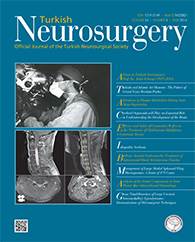2Affiliated 2nd Hospital of Zhejiang Chinese Medical University, School of Medicine, Department of Neurosurgery, Hangzhou Zhejiang, China DOI : 10.5137/1019-5149.JTN.9837-13.2 AIM: External ventricular drainage (EVD) and lumbar drainage (LD) are the most widely used procedures for continued bloody cerebrospinal fluid drainage. Each has his own advantages and disadvantages. Here, we compared complications and clinical outcomes in patients with World Federation of Neurosurgical Societies (WFNS) grade III aneurysmal subarachnoid hemorrhage (aSAH) who underwent coil placement followed by EVD or LD.
MATERIAL and METHODS: In this prospective, controlled study, all patients with aSAH classified as WFNS grade III who underwent coil placement at our institution were divided randomly into 2 groups: the EVD group and the LD group. The ratios of intracerebral hemorrhage, vasospasm, infection, duration of catheter placement, hydrocephalus, and Glasgow outcome scale (GOS) after 2 months of onset were analyzed between the 2 groups.
RESULTS: A total of 148 patients (mean age 56.8 years) were enrolled in this study. Seventy-six patients were assigned to the EVD group, and 72 patients were assigned to the LD group. The average time interval from stroke onset to surgery was 35.1 h. Compared with the EVD group, the LD group had a lower incidence of intracerebral hemorrhage, slightly higher rates of infection and hydrocephalus, and similar vasospasm and chronic hydrocephalus rates, durations of catheter placement, and GOS scores at 2 months after onset.
CONCLUSION: In order to improve the clinical outcomes of patients with aSAH, we suggest that LD is better than EVD for patients with WFNS grade III aSAH who underwent coil placement.
Keywords : Aneurysmal subarachnoid hemorrhage, Bloody cerebrospinal fluid, External ventricular drainage, Lumbar drainage




